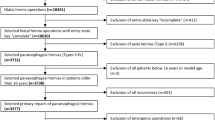Abstract
Background
Patients undergoing laparoscopic paraesophageal hernia (PEH) repair risk substantial morbidity. The aim of the present study was to analyze predictive factors for postoperative morbidity and mortality.
Methods
A total of 354 laparoscopic PEH repairs were analyzed from the database of the Swiss Association for Laparoscopic and Thoracoscopic Surgery (SALTS). Age (<70 and ≥70 years) and risk (low: American Society of Anesthesiologists (ASA) scores 1 + 2; high ASA scores 3 + 4) groups were defined and multivariate logistic regression was conducted.
Results
In patients ≥70 years of age postoperative morbidity (24.4% versus 10.1%; p = 0.001) and mortality (2.4% versus 0%; p = 0.045) were significantly higher than in patients <70 years of age. In patients with gastropexy, this significant age difference was again present (38.8% versus 10.5%; p = 0.001) whereas in patients with fundoplication no difference between age groups occurred (11.9% versus 10.1%; p = 0.65). Mortality did not differ. High-risk patients had a significantly higher morbidity (26.0% versus 11.2%; p = 0.001) but not mortality (2.1% versus 0.4%; p = 0.18). The multivariate logistic regression identified the following variables as influencing postoperative morbidity: Age ≥70 years (Odds Ratio [OR] 1.99 [95% CI 1.06 to 3.74], p = 0.033); ASA 3 + 4 (OR 2.29 [95% Confidence Interval (CI) 1.22 to 4.3]; p = 0.010); type of operation (gastropexy) (OR 2.36 [95% CI 1.27 to 4.37]; p = 0.006).
Conclusions
In patients undergoing laparoscopic paraesophageal hernia repair age, ASA score, and type of operation significantly influence postoperative morbidity and mortality. Morbidity is substantial among elderly patients and those with co-morbidity, questioning the paradigm for surgery in all patients. The indication for surgery must be carefully balanced against the individual patient’s co-morbidities, age, and symptoms, and the potentially life threatening complications.
Similar content being viewed by others
References
Gantert WA, Patti MG, Arcerito M et al (1998) Laparoscopic repair of paraesophageal hiatal hernias. J Am Coll Surg 186:428–432 discussion 432–423
Ferri LE, Feldman LS, Stanbridge D et al (2005) Should laparoscopic paraesophageal hernia repair be abandoned in favour of the open approach? Surg Endosc 19:4–8
Draaisma WA, Gooszen HG, Tournoij E et al (2005) Controversies in paraesophageal hernia repair: a review of literature. Surg Endosc 19:1300–1308
Mehta S, Boddy A, Rhodes M (2006) Review of outcome after laparoscopic paraesophageal hiatal hernia repair. Surg Laparosc Endosc Percutan Tech 16:301–306
Skinner DB, Belsey RH (1967) Surgical management of esophageal reflux and hiatus hernia. Long-term results with 1,030 patients. J Thorac Cardiovasc Surg 53:33–54
Stylopoulos N, Gazelle GS, Rattner DW (2002) Paraesophageal hernias: operation or observation? Ann Surg 236:492–500; discussion 500–501
Parameswaran R, Ali A, Velmurugan S et al (2006) Laparoscopic repair of large paraesophageal hiatus hernia: quality of life and durability. Surg Endosc 20:1221–1224
Targarona EM, Novell J, Vela S et al (2004) Mid term analysis of safety and quality of life after the laparoscopic repair of paraesophageal hiatal hernia. Surg Endosc 18:1045–1050
Zaninotto G, Portale G, Costantini M et al (2007) Objective follow-up after laparoscopic repair of large type III hiatal hernia. Assessment of safety and durability. World J Surg 31:2177–2183
Pierre AF, Luketich JD, Fernando HC et al (2002) Results of laparoscopic repair of giant paraesophageal hernias: 200 consecutive patients. Ann Thorac Surg 74:1909–1915; discussion 1915–1906
Mattar SG, Bowers SP, Galloway KD et al (2002) Long-term outcome of laparoscopic repair of paraesophageal hernia. Surg Endosc 16:745–749
Wu JS, Dunnegan DL, Soper NJ (1999) Clinical and radiologic assessment of laparoscopic paraesophageal hernia repair. Surg Endosc 13:497–502
Hashemi M, Peters JH, DeMeester TR et al (2000) Laparoscopic repair of large type III hiatal hernia: objective followup reveals high recurrence rate. J Am Coll Surg 190:553–560 discussion 560–551
Gangopadhyay N, Perrone JM, Soper NJ et al (2006) Outcomes of laparoscopic pa24raesophageal hernia repair in elderly and high-risk patients. Surgery 140:491–498 discussion 498–499
Edye MB, Canin-Endres J, Gattorno F et al (1998) Durability of laparoscopic repair of paraesophageal hernia. Ann Surg 228:528–535
Casabella F, Sinanan M, Horgan S et al (1996) Systematic use of gastric fundoplication in laparoscopic repair of paraesophageal hernias. Am J Surg 171:485–489
Lal DR, Pellegrini CA, Oelschlager BK (2005) Laparoscopic repair of paraesophageal hernia. Surg Clin North Am 85:105–118
Leeder PC, Smith G, Dehn TC (2003) Laparoscopic management of large paraesophageal hiatal hernia. Surg Endosc 17:1372–1375
Dahlberg PS, Deschamps C, Miller DL et al (2001) Laparoscopic repair of large paraesophageal hiatal hernia. Ann Thorac Surg 72:1125–1129
Oelschlager BK, Pellegrini CA, Hunter J et al (2006) Biologic prosthesis reduces recurrence after laparoscopic paraesophageal hernia repair: a multicenter, prospective, randomized trial. Ann Surg 244:481–490
Brown TM, Boyle MF (2002) Delirium. BMJ 325:644–647
Francis J, Kapoor WN (1992) Prognosis after hospital discharge of older medical patients with delirium. J Am Geriatr Soc 40:601–606
Andujar JJ, Papasavas PK, Birdas T et al (2004) Laparoscopic repair of large paraesophageal hernia is associated with a low incidence of recurrence and reoperation. Surg Endosc 18:444–447
Luketich JD, Raja S, Fernando HC et al (2000) Laparoscopic repair of giant paraesophageal hernia: 100 consecutive cases. Ann Surg 232:608–618
Allen MS, Trastek VF, Deschamps C et al (1993) Intrathoracic stomach. Presentation and results of operation. J Thorac Cardiovasc Surg 105:253–258; discussion 258–259
Diaz S, Brunt LM, Klingensmith ME et al (2003) Laparoscopic paraesophageal hernia repair, a challenging operation: medium-term outcome of 116 patients. J Gastrointest Surg 7:59–66; discussion 66–57
Velanovich V, Karmy-Jones R (2001) Surgical management of paraesophageal hernias: outcome and quality of life analysis. Dig Surg 18:432–437; discussion 437–438
Author information
Authors and Affiliations
Corresponding author
Additional information
H. J. Larusson and U. Zingg equally contributed as first authors.
Rights and permissions
About this article
Cite this article
Larusson, H.J., Zingg, U., Hahnloser, D. et al. Predictive Factors for Morbidity and Mortality in Patients Undergoing Laparoscopic Paraesophageal Hernia Repair: Age, ASA Score and Operation Type Influence Morbidity. World J Surg 33, 980–985 (2009). https://doi.org/10.1007/s00268-009-9958-9
Published:
Issue Date:
DOI: https://doi.org/10.1007/s00268-009-9958-9




